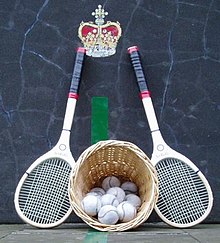Games of gain-ground/Real tennis
|
Games of gain-ground
|
|
Real tennis is a racquet sport. It is also known as court tennis in the United States, formerly royal tennis in England and Australia, and courte-paume in France.  A valid serve must occur from the serving court before the second gallery line, and hit the service penthouse before dropping in the receiving court, marked by the service line and fault line. Corresponding chasse lines extend from the centers of the side galleries on both service and hazard ends, including the first, door, second and last. Gallery posts and the net post are marked with circles. Shaded areas are the winning openings, the dedans, grille, and winning gallery. None of these, nor the posts, would be visible with an actual overhead view as depicted. Courts[edit | edit source]There are two basic designs in existence today: jeu quarré, which is an older design, and jeu à dedans. The more common real tennis court is jeu à dedans. It is enclosed by walls on all four sides, three of which have sloping roofs ("penthouses") beneath which are various openings ("galleries"), and a buttress that intrudes into the playing area (tambour) off which shots may be played. Rules[edit | edit source]The service is always made from the same end of the court (the "service" end); a good service must touch the side penthouse (above and to the left of the server) on the receiver's ("hazard") side of the court before first touching the floor in a marked area on that side. The resulting back-court volleys and the possibility of hitting shots off the sidewalls and the sloping penthouses give many interesting shot choices not available in lawn tennis. Chasses[edit | edit source]When the ball bounces twice on the floor at the service end, a "chasse" (chase) is called where the ball made its second bounce and the server gets the chance, later in the game, to "play off" the chasse from the receiving end; but to win the point being played off, their shot's second bounce must be further from the net (closer to the back wall) than the shot they originally failed to reach. A chasse can also be called at the receiving ("hazard") end, but only on the half of that end nearest the net; this is called a "hazard" chasse. Those areas of the court in which chasses can be called are marked with lines running across the floor, parallel to the net, generally about 1-yard (0.91 m) apart – it is these lines by which the chasses are measured. Additionally, a player can gain the advantage of serving only through skillful play (viz. "laying" a "chasse", which ensures a change of end). This is in stark contrast to lawn tennis, where players alternately serve and receive entire games. In real tennis, the service can only change during a game, and it is not uncommon to see a player serve for several consecutive games till a chasse be made. Indeed, in theory, an entire match could be played with no change of service, the same player serving every point. When there are two chasses, then the receiver becomes a server, i.e. he crosses side service so-called Dedans (or only one chasse if one of the players reaches 40 or advantage in a game).
Points[edit | edit source]Scoring is by fifteens (15, 30, 40) as in lawn tennis. In real tennis, six games wins a set, without the need for a two-game buffer (although some tournaments play up to nine games per set). A match is typically best of three sets, except for the major open tournaments, in which matches are best of five sets for men, and the best of three sets for women. Various window-like openings below the penthouse roofs offer the player a chance to win the point instantly when the ball is hit into the opening These "goals" to be aimed for are =
In other cases, these windows in the gallery create a "chasse".
|
|
Notes and External links
Wikimedia Commons has media related to Category:Jeu de paume. |
|
|




